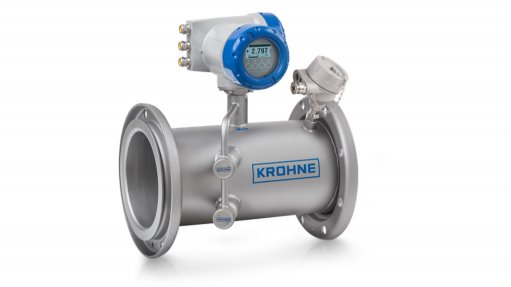
GOING WITH THE FLOW The flowmeter is suited to biogas as well as landfill and sewage gas applications
Industrial process instrumentation supplier Krohne announced the introduction of the new Optisonic 7300 Biogas ultrasonic flowmeter to the Southern African market in the last quarter of last year.
The Optisonic 7300 Biogas is an ultrasonic flowmeter for low-pressure biogas, landfill and sewage gas applications.
The flowmeter is ideally suited to measure biogas with a high carbon dioxide (CO2) content as well as small amounts of other media like hydrogen sulphide, nitrogen, hydrocarbons or condensation water, and has been specially designed to measure dry and wet biogas with variable composition.
The flowmeter overcomes the limitations of the ultrasonic principle in biogas applications owing to high damping of the acoustic signals by CO2 and high-water content in the biogas. Its signal transducers provide a stronger ultrasonic signal into the gas, and specialised signal processing enables better detection of small, strongly dampened acoustic signals. These features, along with the mechanical design of transducers and transducer pockets, make the measurement insensitive to liquid and biological scaling.
It features a maintenance-free full bore flow sensor without any moving parts. Owing to the hydrogen sulphide in biogas being corrosive when dissolved in water, the measuring tube is made of stainless steel 1.4404/316 ℓ and the transducers are made of Nace-approved grade 29 titanium for maximum corrosion resistance. Equipped with lap joint flanges to lower its overall weight, the measurement accuracy is specified at 1% of actual measured flow rate when calibrated with air. When 2% accuracy is sufficient, users can select a dry calibration alternative at a significantly lower price.
Optisonic 7300 Biogas features a built-in temperature sensor that facilitates direct measurement of methane content using calculation of the molar mass, in combination with the measured velocity of sound. This enables end-users to determine the exact methane content of the biogas necessary when it is used as fuel for gas engines in a combined heat unit. It can also provide calculation of gas flow volume to standard conditions by using an additional pressure sensor.
The electronics include diagnostics to validate the flowmeter functions and the process. For output of the measured values, four to 20 mA and pulse outputs are available, while HART and the option of Modbus are included for field communication.
The flowmeter provides additional functions like calculation of standard volume, methane content measurement, and diagnostics features. It also features no moving parts and no pressure loss.
The flowmeter is certified for use in explosive areas. Since no pressure drop is generally allowed in biogas pipelines, the device is available in common line sizes of two, three, four, six and eight inches.